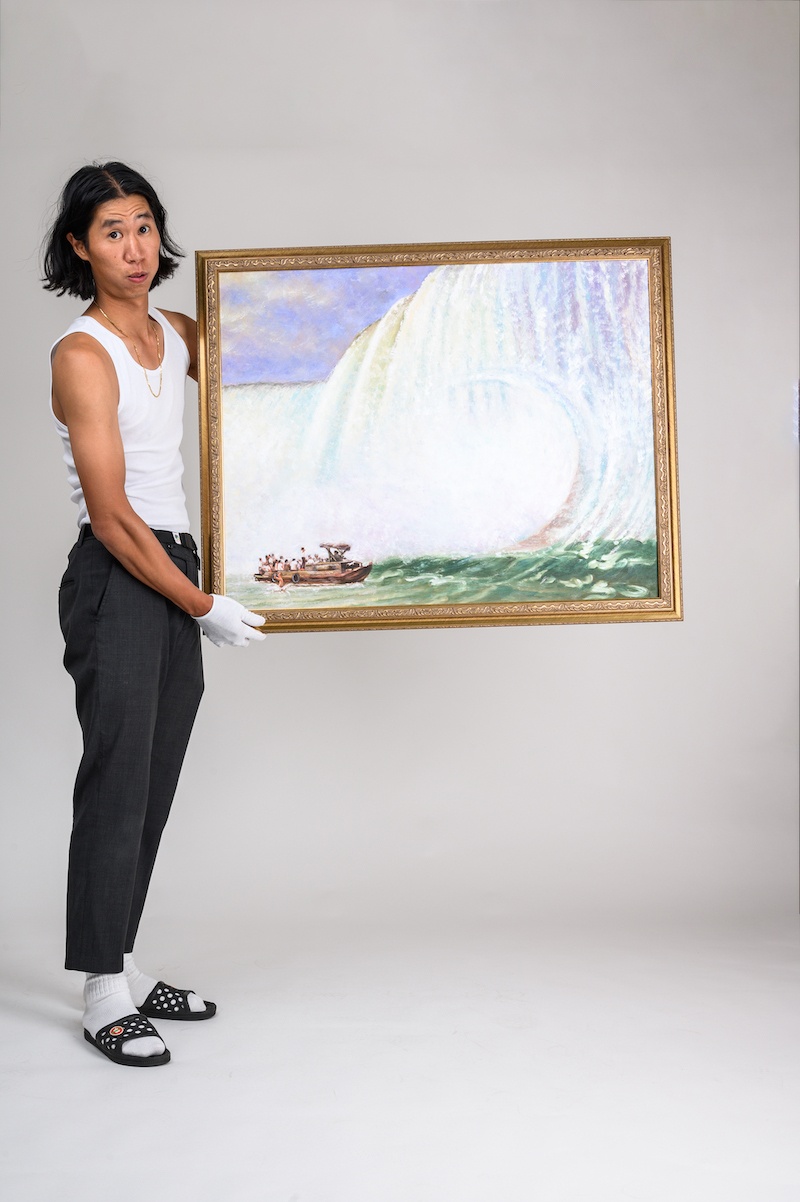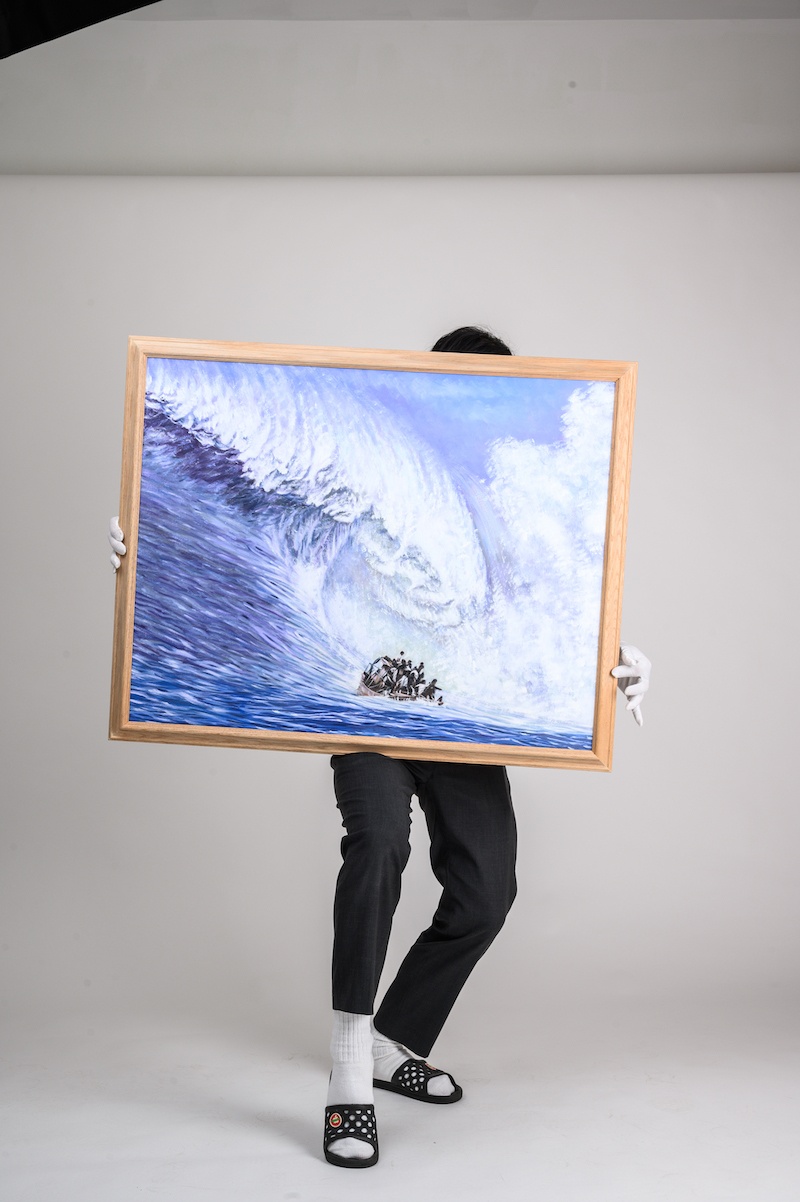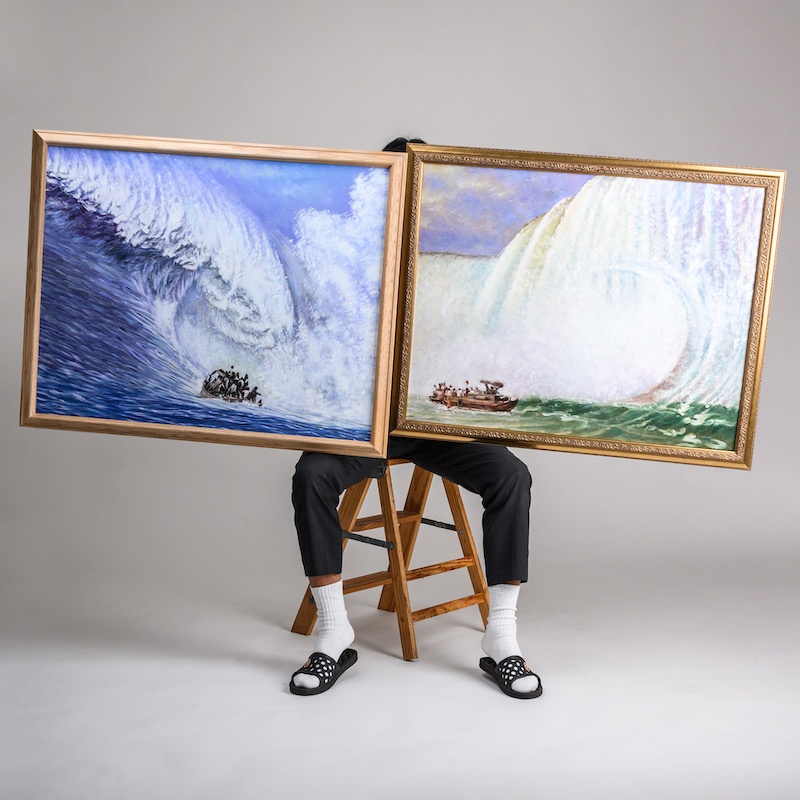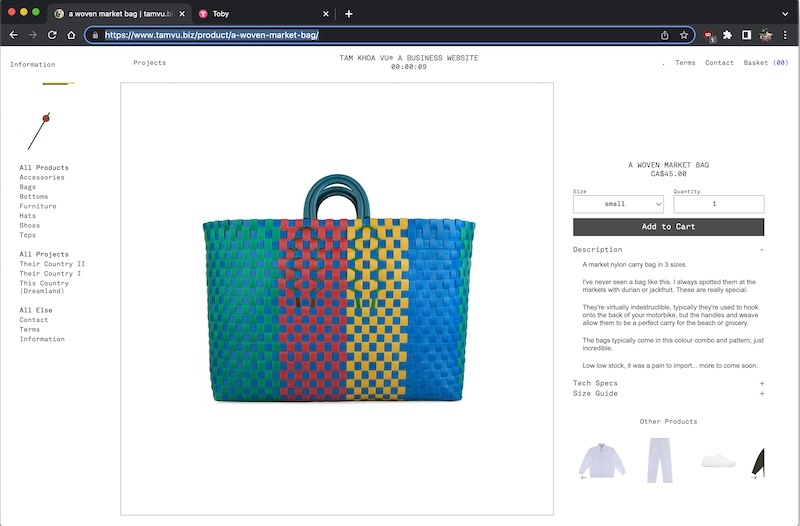On your website, you have the quote that says “being Vietnamese means realizing you belong to a community and identity that spans the globe and isn’t just restricted to Vietnam, the country.” Can you explain what these words mean to you as a Vietnamese Canadian?
That was from a Vietnamese director named Bao Nguyen. It resonated so much with me because much of my work focuses on Vietnamese identity and diaspora. Because Vietnamese people were displaced all over the world, people of our generation are now contemplating what it means to be Vietnamese and how it doesn’t just mean you’re limited to being in Vietnam. The way he puts it doesn’t use any crazy ideas or rhetoric or words, and it is exactly in line with how I want to push my own messaging.
A lot of your work centers on collaboration. Through your import business TKV® Fine Arts & Financial Arts, you work with your cousin Lap who runs purchasing in Vietnam and supplies your online store. For the piece ‘Waves like a Wall’ you collaborated with painters in HCMC and asked them to create a scene based on American Realism references you provided. Can you talk about the significance of working with artists and family members based in Vietnam?
I was having this conversation with my friend Galen early on in this project and he was like, “Tam, you’ve made production and supply chain an art practice.” And I was like, “Oh, that’s such a beautiful way to see it,” because it’s true. I come from a production managing background where I coordinate teams, organize schedules, and talk to vendors. With painting, composition is just not in my tool bag so I choose to work with other artists. I have all of these ideas, but the painting, actual painting, is not the important part—it’s really the conversations in between. The work facilitates conversations that I have with the painter, or with my mom, that the audience gets to interpret as well.
When I messaged the painter I was like, “Hey, maybe for these next paintings, could I just give you a paragraph of the stories and then send you a couple of reference images of the people that I want in the scene? And maybe they’re wearing these slides and have these bags.” And she was like, “Yeah, but know that the painter should have free hand to paint.” I was like, “Perfect.” It only strengthens this whole project too, where it’s essentially that translation of communications.
On an Instagram post, you wrote “Someone recently told me they were on www.tamvu.biz and they didn’t know if it was a real business or an art project.” From my perspective, it seems like every part of your practice and every part of the process is art. What do you think of this?
Yeah, I love when people are confused in that way. Somebody I was speaking to recently was like, “Your business is performance art.” I definitely put on a bit of a personality, but largely it’s still me. Having myself be a part of it is what makes me feel I can promote comfortably. On Instagram, you build up this archetype that’s judging you all the time and it’s like, “Okay. Actually, how do I self-promote so I don’t have to appease that person I’m imagining is judging me and be comfortable with what I do?” But yeah, all of it feeds into each other.
I feel like your personality also comes through in your artist statements and in your Instagram posts. Was that a choice ever or is that just natural?
When I was starting the business, I went through all these business planning and marketing workshops because I didn’t want to feel like I was missing something that somebody that went to a business school already knew. I was trying to catch up. In one of these programs, I was paired with a mentor who helped me go from having a business plan to the launch of the project.
I remember we were getting down to the final days before the website launch I had all my photographs taken, the e-com was set up and I typed up filler copy for the site. We were having weekly meetings when I mentioned I might have to push the launch another week. He was like, “What’s missing?” And I was like, “The body copy. I want to tighten it up and fiddle with it a little bit.” And he was like, “Honestly, you should just think of it like a restaurant. Just launch. Open the door and see who comes in. You don’t need to turn on the open sign, just open the door.” And so that’s exactly what I did. And the feedback was, “Wow, your copy is so amazing.” I was like, “If you like that, I can write train of thought all day.” I felt confident then that my voice was enough.
I think it’s a good intuition to just follow what comes naturally. In talking about the written word, I was reading an interview with you this morning where you were discussing the oral history of some of the clothing or the objects that you sell. How do you feel about educating other people about these items that may not know their original context?
I feel like I’m educating myself at the same time. I don’t have all the answers and I’m learning and I get things wrong. I saw a lot of these objects when I was visiting when I was younger and I was always drawn to them. Going back as an adult and after having gone through design school, I was still drawn to them and wanted to see if other people were as well. There’s a magic to them, and I’m still curious as to why.
I wouldn’t say educating others is tedious or taxing, it’s part of the business and the art practice. Also ultimately, the real audience I’m trying to please is a 12-year-old me who’s skateboarding or listening to punk music and is unsure of their place in the world. And I really just want to say, “Hey, all of our cultural identity is entirely valid, and we should just be stoked.” And so really who I’m trying to educate is not the people that are disconnected to it, but to someone that maybe should feel connected to it.
Do you feel like you learn about yourself through your art practice?
Yeah, especially when I talk about myself or talk to other people. I learn from my friends a lot. They’re often able to summarize my verbal ideation vomit and be like, “Oh, okay. I see what you’re trying to do or say.” I get to use their summaries for conversations like this.
Do you feel supported in Montreal and in Montreal’s community? Or where do you find support?
I love Montreal, it’s the best. I feel so at home here in the way that if I was trying to build a house from scratch, I’m sure in Montreal, I could ask three people and they might know somebody and eventually, we could do it. But through my art practice, I have been able to draw a Vietnamese community toward me. I’ve spent so long in Montreal and I have less than five Vietnamese friends.
Have you found that that’s changed since the launch?
During an exhibition I put on, I had young Vietnamese people come through and just say like, “Wow, thank you. I thought I was alone in this.” And it really made me tear up because that’s exactly who I want to do it for. It’s for those people. And so that was really cool.
How do you recharge? Does all of that become overwhelming?
Sometimes, yeah. If I find myself taking multiple naps a day, or there are things on my to-do list that get snoozed every day, I have to ask myself the hard question of like, “Why am I snoozing this so much?” I’m not afraid to take a week off where I’m just like, “Oh, I’m totally tapped.”
You quit your job during the beginning of the pandemic and launched TKV Business and Fine Arts. Was there a turning point where you’re like, “I need to start this?” Was the idea percolating?
I like to use the word retire. It was all happening within the month of March when there was so much instability coupled with the pandemic and nobody knew what was going on. At that time, my partner’s grandfather was dying of cancer so we went to rural Ottawa to support the family. We were in the countryside supporting this person that had three months to live and when you’re faced with someone that’s dying, they’re not talking about money or jobs, they’re like “Wow, I’m so thankful that I have the people that I love around me to be helping me through this thing.” When you see that it stirs something inside of you, too, where you’re like, “When I’m making a lot of money, I can just find creative ways to spend it. But actually, how much do I need?” At that point, I was fully into the business I was working at. Because I don’t come from money, it was really exciting to have the kind of money where you get to go to the restaurant and you’re not looking at the number beside it. You’re like, “Oh the words. I want to eat this word.” But I got to a point where I was like, “Wait, that’s not important. The time is so important and doing what you want to do.” I don’t want to go to bed on Sunday just being afraid of Monday. Life can pass you by in that way.
I have to say, working in fashion and then taking your knowledge and creating something so profoundly personal is such a beautiful thing to do. And also really brave.
Yeah, thank you. I think too, for me, it was like, “How do I make this my own?” I can’t compete with these other fashion brands that are doing this and that, I can’t play that game. I keep thinking about that moment where I was like, “Hey, my identity and my perspective is valid.” Maybe it doesn’t resonate with everyone, but the people that it connects with, they’ll feel like, “Yeah. Fuck yeah. This really resonates.”
I have one more question on that note. You said before, that when you’re thinking about who you’re creating this for, you’re picturing a younger version of yourself. What would you say to 12-year-old Tam?
Just do something. Just do. Think a little bit, but mostly just do. Put your money where your mouth is. The nice thing about exhibiting these artworks was seeing a lot of people come through and resonate with them and also realizing I’m not here to put everyone on my back. I’m just going to take a shovel and try to build a little bit of a path. And if you want to get a shovel and build a little bit of a path too, then go on. And if we can all do that, then we’re going to have a freaking nice highway, it’s going to be sweet. Or maybe we’re not, and it’s going to have pylons everywhere, but at least we have something. Mostly, just not to be afraid to do things. And do things because you want to do things, not because somebody else is telling you to do things.
Tam Vu Recommends:
@waxmaya, @bug.mtl, and @j.30000 are all long-time friends of mine. I love and respect them so much—they are out there taking risks, doing what they love, and making things happen. The hardest part is always doing, and I love that they do. They are truly inspirational.
Kim (@vietnamemes__) and Vinh (@tontondetente) are among the funniest, freshest, and most creative Vietnamese diasporic voices. This is the future, they are the best. If you’re not laughing, you’re really crying.
This content originally appeared on The Creative Independent and was authored by Lauren Spear.
Lauren Spear | Radio Free (2022-09-13T07:00:00+00:00) Visual artist Tam Vu on not being afraid to just do it. Retrieved from https://www.radiofree.org/2022/09/13/visual-artist-tam-vu-on-not-being-afraid-to-just-do-it/
Please log in to upload a file.
There are no updates yet.
Click the Upload button above to add an update.



